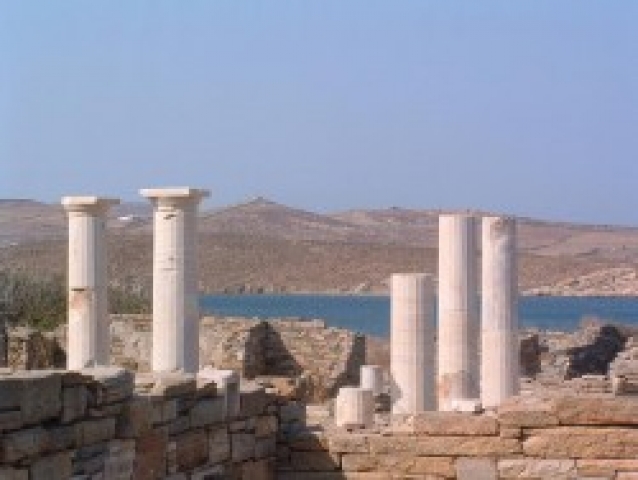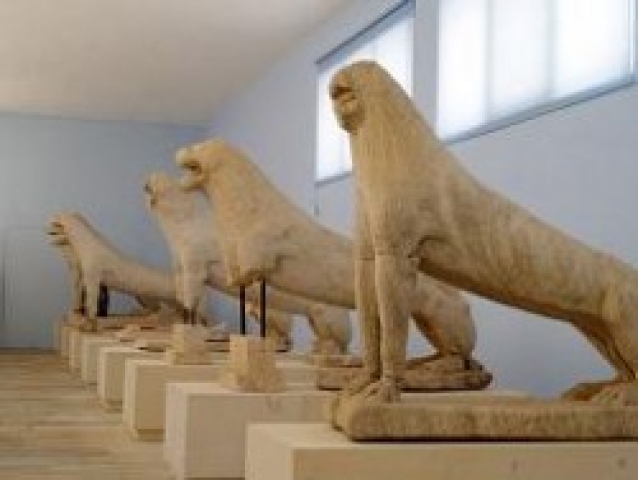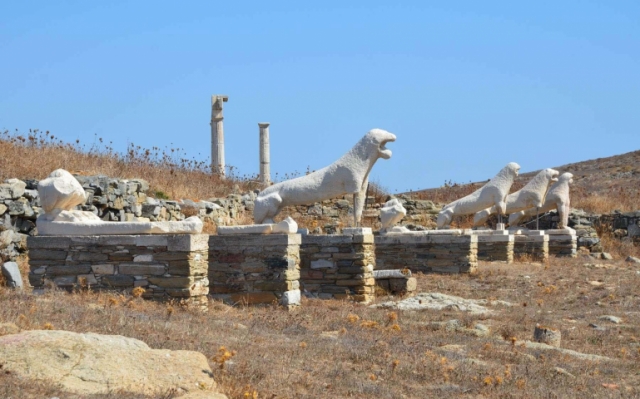Press here.
Prefecture: Cyclades

Places near Pythio
This long structure once held a giant trireme, the flagship of Antigonus II Gonatas, which he offered as a dedicatory display, to celebrate the victory at Kos against the Ptolemaics in 255 BC.
Oikos translates roughly as "family unit," and this building was meant to connect the "family" of Naxos to the family of Apollo. The Naxians had been building temples here since the 7th century BC, but this ruin primarily dates from the 6th century and later. (If you look closely, you can see a couple of holes in the exposed bedrock within the courtyard. These would have held the original wooden columns of the first building.) The Oikos was most famous for its huge statue of Apollo, nearly 8 meters tall, which tumbled over in a huge storm sometime in the 4th century BC. Although it was later re-erected, time, pirates, and the elements have reduced it to a couple of very worn lumps of brilliant white marble.
A gamma-shaped structure, situated on the southwest side of the Sanctuary of Apollo, in contact with the Propylaea.
Where Leto gave birth to Apollo. It's one of the few places on the island with natural spring water fairly close to the surface, so it made an obvious choice for an area symbolic of the beginnings of divine life.
in this house they found the headless statues of the owners, Dioskourides and his wife Cleopatra, a couple from Athens; they were erected in 138 BC by Cleopatra after the death of her husband; French archaeologists chose to name the house after her, a decision which increases the number of visitors, but disappoints those of them who believed there was a link between the location and Cleopatra VII, the famous Egyptian queen. Cleopatra is a Greek name meaning "glory of her father".
Mt. Cynthus
If you visit Delos consider hiking to this hill, you get a view of almost the entire island and a sense for how important the place was historically.
One of the three temples of Apollo, built by the Athenians and specifically by Peisistratos around 530-510 BC. The temple was housing a statue of Apollo. It is the oldest of the three temples of Apollo.
On the left from the harbor is the Agora of the Competialists (circa 150 BC), members of Roman guilds, mostly freedmen and slaves from Sicily who worked for Italian traders. They worshiped the Lares Competales, the Roman "crossroads" gods; in Greek they were known as Hermaistai, after the god Hermes, protector of merchants and the crossroads.
Agora of the Competialists, an open yard, surrounded by shops, small temples and altars, is the first monument that the visitors see, entering the archaeological site of Delos. Here were the stores of the merchants of the association of Roman citizens and liberalized slaves, who worshiped the gods of the "crossroads", the Lares Competales. However, the market served also other traders, Hermaists and Apolloniasts.
A temple dedicated, probably, to the mythic Greek goddess Tyche (meaning "luck" in Greek), who was the personification of fortune, prosperity and wealth. The Roman equivalent was the goddess Fortuna.
Delos Archaelogical Museum
The Delos Museum was built in 1904, with the expense of the Athens Archaeological Society. The original building included the five western rooms, plus several more in 1931 and 1972. In the same period there have been huge, but unfortunate, modifications in the appearance of the building.
The present exhibition contains nine galleries: six of them contain sculptures and reliefs found on Delos, one of the best collections in the world. Two rooms hold pottery dating to the prehistoric and late-hellenistic periods and a final room showcases the various miniature objects found in the private homes of Delos. The exhibition is not yet complete.
Collections
The most important collections include:
Statues and columns of the 7th - 1st century BC
Vases of instruments of the 3rd millennium - 1st century BC
Idols 2nd - 1st century BC
Jewelry and small items of 2nd - 1st century BC
Mosaics of 2nd - 1st century BC
Exhibits
The key exhibits include:
a plate with ivory relief of Mycenean warrior that was found in Artemision
a torso Kouros from the temple of Apollo
a marble cluster Vorrea which snaps the princess of Attica Oreithyia and was located in the temple of Athens
statues belonging to Dioskouridi and his wife, Cleopatra -- Athenians living in Delos - found at the home of the couple, in the area of theatre,
a statue of Apollo in the press of the Lyceum of Praxitelous Apollo - the god based in the trunk of a tree and clicks on Gallic shields - from the area of theatre,
a bronze facade bearded Dionysus who diadima bodies and ivy wreath and found south of the Market Kompetaliaston, Corinthian alabaster - a vase for perfumed oil with a Potnias Thiron between two swans - found in Iraio,
a headed triangular pedestal Kouros statue - with relief head crushed in a corner gorgoneia and the other two - from the Temple of Apollo,
an Archaic daughter, which is decorated in the middle of the front with vertical film debossed double meandros - found in the Temple of Apollo, and is considered one of the oldest existing large plastic,
a fresco from the outside wall of a house in the area where Skardana represented by Hercules, and two pygmachoi male form plays flute or trumpet.
One of most evocative sights of Delos is the 164-foot-long Avenue of the Lions. These are replicas; the originals are in the museum. The five Naxian marble beasts crouch on their haunches, their forelegs stiffly upright, vigilant guardians of the Sacred Lake. They are the survivors of a line of at least nine lions, erected in the second half of the 7th century BC by the Naxians. One, removed in the 17th century, now guards the Arsenal of Venice.
Public tank, constructed to collect water from the river Inopos, the sacred river of Delos, that its springs were on the Mt. Kynthos and also believed to contact underground with the river Nile in Egypt. The water used for the ceremonies of the Egyptian sanctuaries.
A building erected by traders from the Levant, who worshiped Poseidon, among other gods. (Makes sense for people who made their living from the sea trade.) There is a stone here that describes who built the place and what they were about: TO KOINON BHRYTION POSEIDONIAS - the Poseidon League of Beirut.) Built around the end of the 2nd century BC.
This temple of Apollo is chronologically the second one that was built in the sanctuary. Tough to imagine, but this humble pile of rubble used to be one of the more impressive monuments on the island. Started by the Athenians when they controlled Delos, sometime around 475 BC, it wasn't finished for another hundred years or so.
In this area there are temples that are dedicated to Egyptian Gods.
Large market square surrounded by two stories of shops. There was also a public bath house. Built in the latter 2nd century BC, when the Romans were pretty well settled on the island.
Group of private dwellings, named for the seasonal stream, Inopos, one of the only ones on the island. The waters were sacred, and were supposed to flow directly from the waters of the Nile River in Egypt.
Residential and commercial district. Most structures date from around the second or third century BC. Strolling up the road, you really get a good impression of what the ancient settlement was like. Actually, it's very much like walking the narrow streets of Mykonos. Minus the gay bars, of course.
One of the more complete houses. Mosaics feature theatrical masks, and a stunning floor with the god Dyonysus riding on a panther
The monumental gateway leading to the sacred precinct of Apollo. The version that survives (basically just the massive marble platform and a few doric column stumps) was built by the Athenians when they still controlled the island--with tacit approval from the Romans--in the 2nd century BC.
It was the sanctuary of the Syrian gods, built probably around the middle of the 2nd century BC. This sanctuary was the place of worship of goddess Atargate and her partner Adas.
This was a Sanctuary built by Egyptian merchants, around 200 BC. It was the place of worship of the ancient Greek-Egyptian god Sarapis (or Serapis) and goddess Isida, and later Anubis and Horus, who was called by the ancient Greeks Arpokratis
It is located on the west side of the Sacred Way and was a commercial arcade with many shops. It was constructed by the Greek King Philippos V of Macedonia.
There are two tombs, the tomb of Argi and Opida and the tomb of Laodiki and Yperochi. They are associated with the worship of the mythical Hyperborean (northernmost) Virgins and the myth of goddess Leto. Hyperborean Virgins were the daughters of Hyperborean people whose origin is unclear.
A palaestra was an athletic "club" where sports such as wrestling or boxing would be taught and practiced. This one featured granite columns and a pool in the middle of the courtyard. It was built sometime in the 2nd century BC
A temple dedicated to ancient Greek goddess Demeter, also being invoked as Thesmophoros.
Dedicated to the son of Apollo, who, legend has it, was the first king of Delos. Early 6th century BC, which makes it one of the oldest structures on the island, although nearby are the remains of tombs dating from a century earlier
The Minoan Fountain was a rectangular public well, hewn in the rock, with a central column; it formalized the sacred spring in its present 6th century BC form, reconstructed in 166 BC, according to an inscription.
Residential and commercial area backing up the small stadium, which is the vaguely ovoid area just to the west. The stadium itself was probably built in the early 3rd century BC. Not much remains, but you can see the remains of a few tiers of seats.
From the mid 2nd century, a small Jewish community lived on Delos, most likely traders like the other Levantine residents. This synagogue dates from sometime in the 1st century BC






